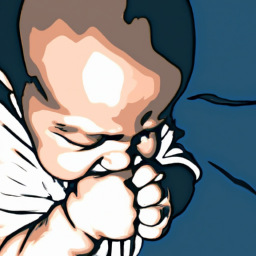As a new parent, I often find myself pondering the different factors that could affect the well-being and happiness of my baby. Recently, I have been wondering about what age infants may start experiencing nightmares. Since nightmares can be upsetting for adults, it’s natural to wonder if our little ones go through similar disruptions.
From what I’ve learned, babies can start dreaming as early as in the womb. In fact, some studies have shown that fetuses exhibit rapid eye movement (REM) sleep, which is when most dreams occur, as early as at 23 weeks of gestation. But when do these dreams turn into nightmares, and how can we tell if our babies are having them?
In this article, we’ll explore the science behind baby dreams, discuss when babies may start having nightmares, and provide some techniques to soothe your little one if they seem to be having a rough night.
Key Takeaways
- Babies can start dreaming in the womb, with REM sleep at 23 weeks gestation.
- Baby dreams are primarily visual and auditory stimuli from the day.
- Nightmares can occur in toddlers during the second half of the night during REM sleep.
- Factors that trigger nightmares include scary media or traumatic events.
The Science Behind Baby Dreams
You might be wondering why your little one is experiencing those cute yet mysterious baby dreams. Well, let’s dive into the science behind it!
Babies are capable of dreaming just like adults. However, their dreams are different from ours due to their limited life experiences and cognitive abilities. Research suggests that babies’ dreams are primarily composed of visual and auditory stimuli they have encountered throughout the day. For example, if your baby saw a red balloon during the day, they may dream about it at night.
Additionally, babies’ brains are more active during sleep, which may contribute to the vividness of their dreams. However, it’s important to note that the exact nature and function of baby dreams are still not fully understood by scientists.
As we explore further, we’ll find out when babies start having nightmares and what impact it can have on their sleep patterns.
When Do Babies Start Having Nightmares?
Once your little one enters the toddler stage, their mind may conjure up frightening scenarios during sleep. This is the time when they may start having nightmares.
It’s important to understand that a nightmare is different from a night terror. Nightmares usually happen during the second half of the night when the child is in REM sleep and can remember the bad dream upon waking up. On the other hand, night terrors happen during non-REM sleep and the child usually doesn’t remember them upon waking up.
Several factors may trigger nightmares in toddlers. These include watching scary movies or TV shows, reading scary books, or experiencing a traumatic event. Some children may also have nightmares if they are overtired or haven’t had enough sleep.
If your child is having nightmares, they may wake up crying, screaming, or sweating. It’s important to comfort them and let them know that they are safe.
In the next section, we will discuss some signs your baby may be having bad dreams.
Signs Your Baby May Be Having Bad Dreams
Imagine your little one tossing and turning in their sleep, whimpering softly and exhibiting signs of distress. These could be indications that they’re experiencing unsettling dreams that are causing them discomfort.
While it’s difficult to confirm when babies start having bad dreams, it’s important to recognize the signs that suggest they’re having them. Some common signs include crying, whimpering, and fussing during sleep, as well as a refusal to go back to sleep after waking up.
Another common sign that your baby may be having bad dreams is if they wake up multiple times during the night. If this happens, try to comfort them by holding them, singing softly, or offering a pacifier.
Additionally, make sure their sleep environment is comfortable and soothing, with a consistent bedtime routine. By creating a calm and relaxing environment, you can help your little one feel safe and secure, even when they’re experiencing unsettling dreams.
These techniques can help your baby feel more comfortable when they wake up from a bad dream, and can help them sleep better overall.
Techniques to Soothe Your Baby
Creating a peaceful sleep environment with a consistent bedtime routine can help your little one feel safe and calm, allowing them to drift off into a peaceful slumber. Here are four techniques to soothe your baby and promote a restful night’s sleep:
-
Use white noise: Soft sounds like white noise can help your baby fall asleep and stay asleep throughout the night. You can use a white noise machine or simply turn on a fan in your baby’s room.
-
Swaddle your baby: Swaddling can help your baby feel secure and calm. It can also prevent your baby from waking up due to startle reflexes. Make sure to swaddle your baby safely and securely, with their arms tucked in and snug but not too tight.
-
Rock or bounce your baby: Gentle rocking or bouncing can help soothe your baby and promote relaxation. You can use a rocking chair or a baby swing to help lull your little one to sleep.
-
Establish a bedtime routine: A consistent bedtime routine can help your baby feel calm and relaxed before bed. This can include a bath, storytime, and a lullaby. Stick to the same routine every night to help your baby associate these activities with sleep.
By using these techniques, you can help your baby feel calm and relaxed before bed, promoting a restful night’s sleep. However, if your baby continues to experience bad dreams or has trouble sleeping, it may be time to seek professional help.
When to Seek Professional Help
If your little one is consistently struggling to fall asleep or stay asleep, it’s important that you seek professional help to ensure they are getting the rest they need for their overall well-being.
Sleep is crucial for a child’s growth and development, and a lack of it can lead to a range of issues, from behavioral problems to developmental delays.
There are several signs that may indicate your child needs professional help for sleep-related issues. These include excessive daytime sleepiness, frequent night waking, difficulty falling asleep or staying asleep, and loud snoring or gasping during sleep.
A pediatrician or sleep specialist can help diagnose and address any underlying medical issues or behavioral problems that may be affecting your child’s sleep, and recommend appropriate treatment options to improve their overall sleep quality.
Frequently Asked Questions
What foods should I avoid giving my baby to prevent bad dreams?
As a parent, I avoid giving my baby sugary or spicy foods that could disrupt their sleep. Instead, I stick to wholesome and nutritious options. Remember, a good night’s sleep is key to a happy baby.
Can babies have good dreams?
Yes, babies can have good dreams. As a parent, it’s important to create a safe and nurturing environment to encourage positive sleep experiences. Reading a soothing story or singing a lullaby can help promote peaceful dreams.
Is it normal for babies to cry or move a lot during their sleep?
Yes, it is normal for babies to cry or move a lot during their sleep. This could be due to a number of reasons such as hunger, discomfort, or needing a diaper change.
How long do baby nightmares typically last?
Baby nightmares typically last a few minutes, but it can feel like forever for us parents. It’s important to comfort and reassure your baby during these moments and allow them to settle back into a peaceful sleep.
Can a baby’s bad dreams be caused by a traumatic experience?
I researched and found that babies can have bad dreams as early as six months old. Traumatic experiences can cause bad dreams in infants, leading to distress and disrupted sleep patterns.
Conclusion
So there you have it, folks. As a new parent, it’s natural to worry about your baby’s sleep, including their dreams. While the science behind baby dreams is still not fully understood, we do know that babies do dream, and they can have bad dreams too.
According to a study by the University of Sheffield, up to 70% of children aged 3-5 years old experience nightmares. This statistic may seem alarming, but it’s important to remember that nightmares are a normal part of childhood development and usually don’t indicate a serious problem.
With some patience and techniques to soothe your baby, you can help them get through any bad dreams they may have. And if you’re ever concerned, don’t hesitate to seek professional help from your pediatrician.
Happy dreaming!










